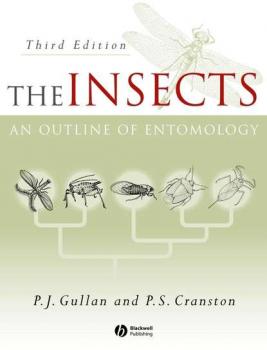ТОП просматриваемых книг сайта:
P. Gullan J.
Список книг автора P. Gullan J.Аннотация
This established, popular textbook provides a stimulating and comprehensive introduction to the insects, the animals that represent over half of the planet's biological diversity. In this new fourth edition, the authors introduce the key features of insect structure, function, behavior, ecology and classification, placed within the latest ideas on insect evolution. Much of the book is organised around major biological themes – living on the ground, in water, on plants, in colonies, and as predators, parasites/parasitoids and prey. A strong evolutionary theme is maintained throughout. The ever-growing economic importance of insects is emphasized in new boxes on insect pests, and in chapters on medical and veterinary entomology, and pest management. Updated 'taxoboxes' provide concise information on all aspects of each of the 27 major groupings (orders) of insects. Key Features: All chapters thoroughly updated with the latest results from international studies Accompanying website with downloadable illustrations and links to video clips All chapters to include new text boxes of topical issues and studies Major revision of systematic and taxonomy chapter Still beautifully illustrated with more new illustrations from the artist, Karina McInnes A companion resources site is available at www.wiley.com/go/gullan/insects. This site includes: Copies of the figures from the book for downloading, along with a PDF of the captions. Colour versions of key figures from the book A list of useful web links for each chapter, selected by the author.
Аннотация
TO ACCESS THE ARTWORK FROM THE BOOK, PLEASE VISIT www.blackwellpublishing.com/gullan. This established and popular textbook is the definitive guide to the study of insects; a group of animals that represent over half of the planet’s biological diversity. Completely updated and expanded, this new edition examines all aspects of insect biology including anatomy and physiology, ecology and evolution of insects, insect behaviours such as sociality, predation, parasitism and defense, medical and veterinary entomology and methods of collection, preserving and identifying insects. Features new chapters on the methods and results of studies of insect phylogeny and a new review of insect evolution and biogeography. Includes expanded sections on species diversity, social behaviour, pest management, aquatic entomology, parasitology and medical entomology. Successful strategies in insect conservation are also covered for the first time, reflecting the increasing threat to natural ecosystems from environmental changes. Boxes highlighting key themes, suggestions for further reading and illustrations, including specially commissioned drawings and colour plates, are included throughout. The artwork from the text is available for instructors either via CD-ROM or by visiting www.blackwellpublishing.com/gullan.
Аннотация
Insects represent over half of the planet’s biological diversity. This popular textbook provides a comprehensive introduction to this extraordinary diversity, and places entomology central to the theory and practice of evolutionary and ecological studies. Fully revised, this fifth edition opens with a chapter concerning the popular side of insect studies, including insects in citizen science, zoos and butterfly houses, and insects as food for humans and animals. Key features of insect structure, function, behaviour, ecology and classification are integrated with appropriate molecular studies. Much of the book is organized around major biological themes: living on the ground, in water, on plants, in colonies, and as predators, parasites/parasitoids and prey insects. A strong evolutionary theme is maintained throughout. There is major revision to the chapter on systematics and a new chapter, Insects in a Changing World, includes insect responses to, and the consequences of, both climate change and human-assisted global alterations to distributions. Updated ‘Taxoboxes’ demonstrate topical issues and provide concise information on all aspects of each of the 28 major groupings (orders) of insects, plus the three orders of non-insect hexapods. New boxes describe a worrying increase in insect threats to landscape and commercial trees (including eucalypts, palms and coffee) and explain the value of genetic data, including evolutionary developmental biology and DNA barcoding, in insect biodiversity studies. The authors maintain the clarity and conciseness of earlier editions, and extend the profuse illustrations with new hand-drawn figures. Over 50 colour photographs, together with the informative text and an accompanying website with links to video clips, appendices, textboxes and further reading lists, encourage a deeper scientific study of insects. The book is intended as the principal text for students studying entomology, as well as a reference text for undergraduate and graduate courses in the fields of ecology, agriculture, fisheries and forestry, palaeontology, zoology, and medical and veterinary science.



